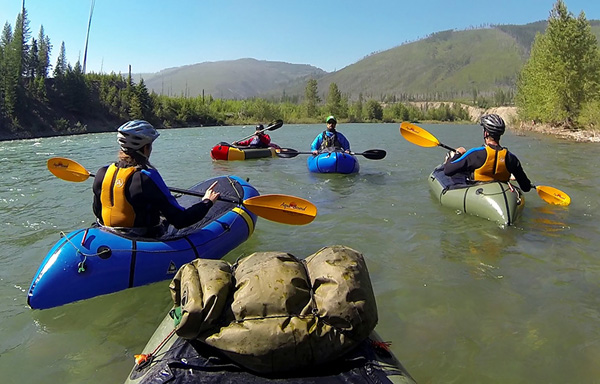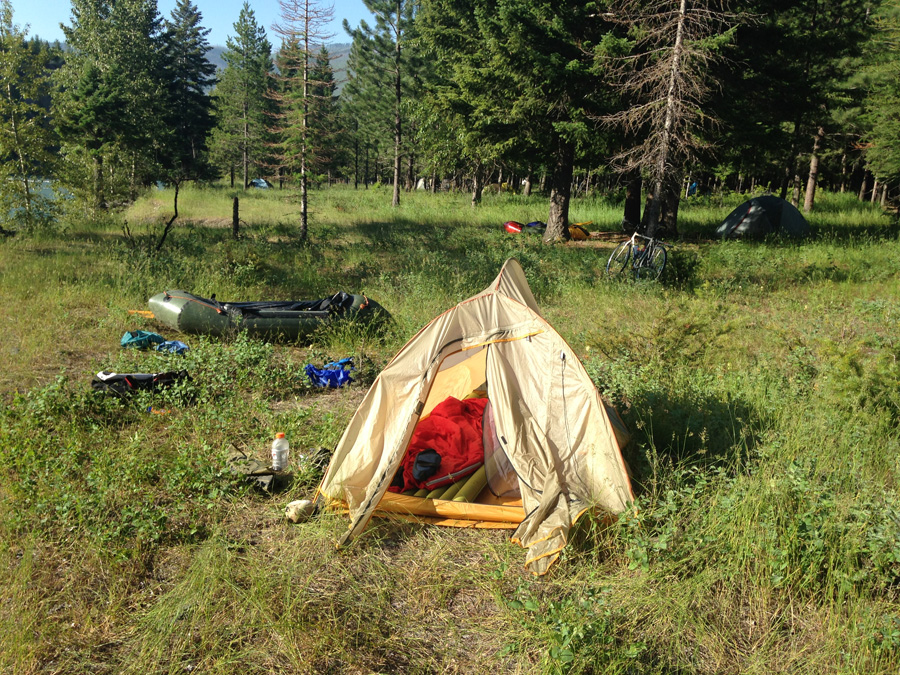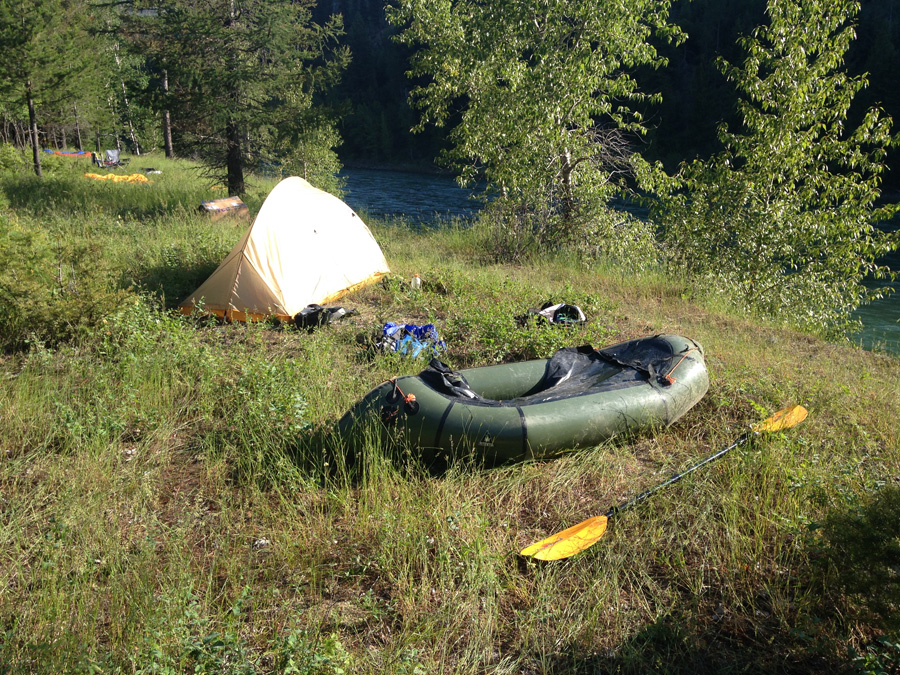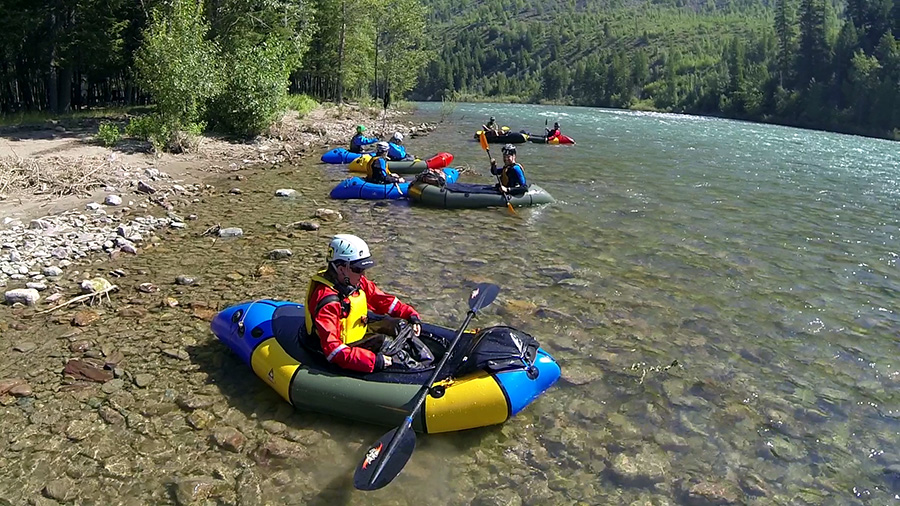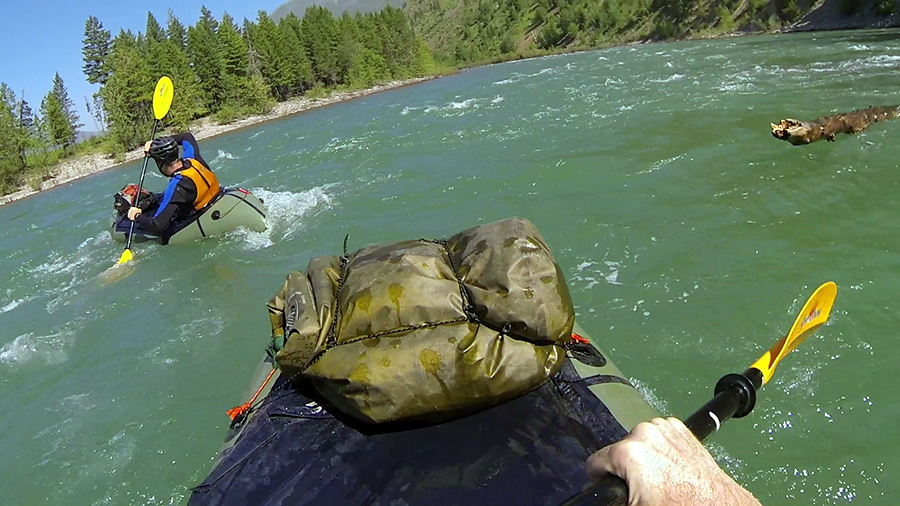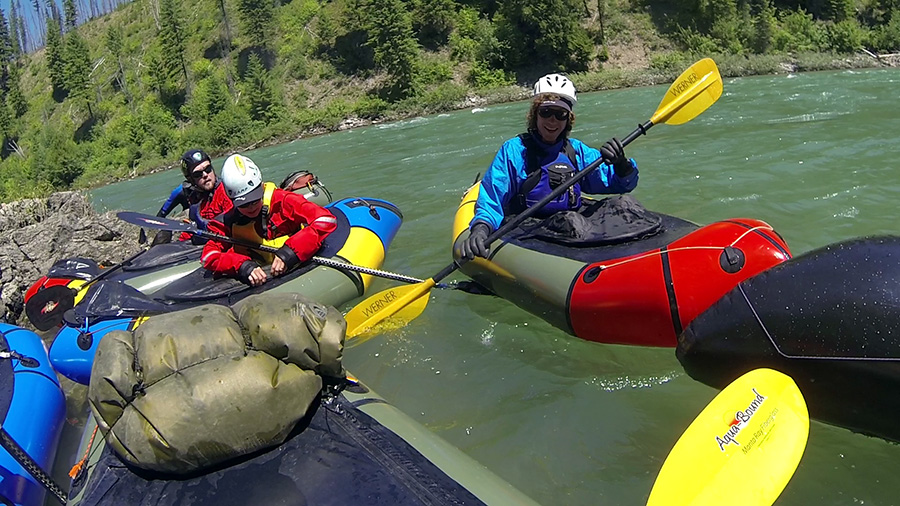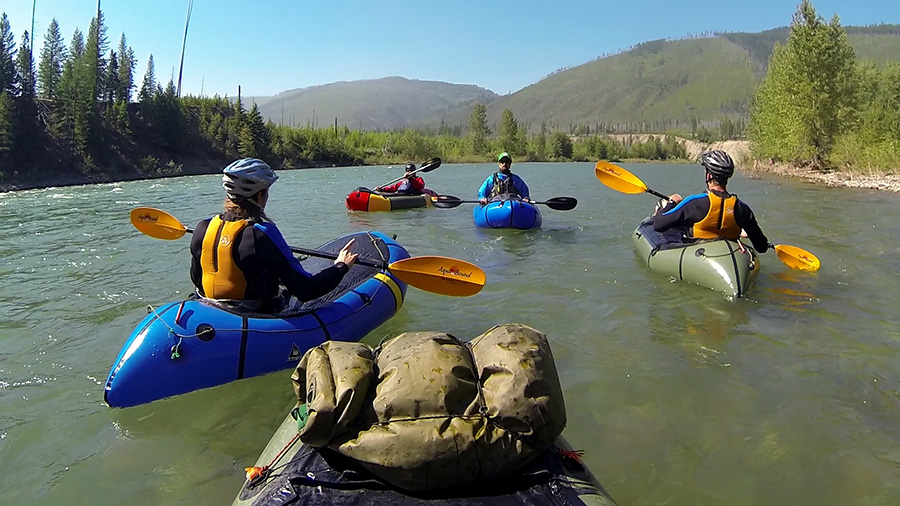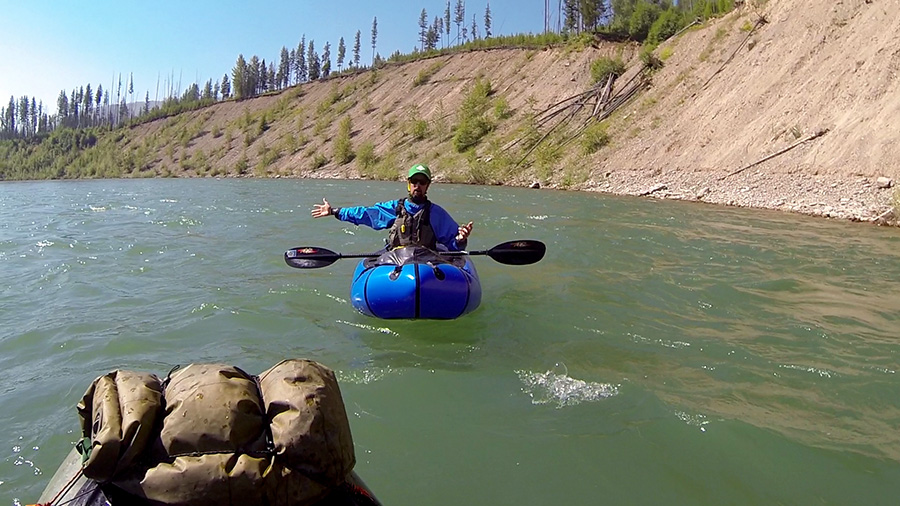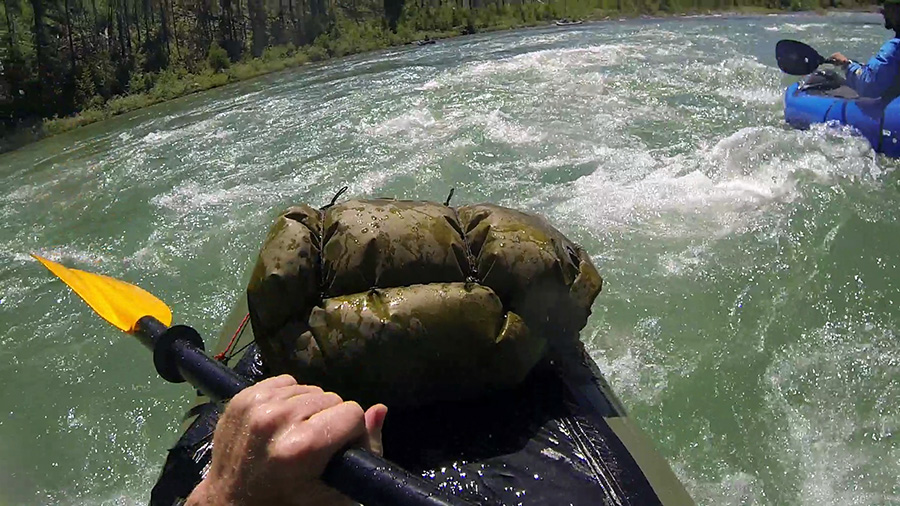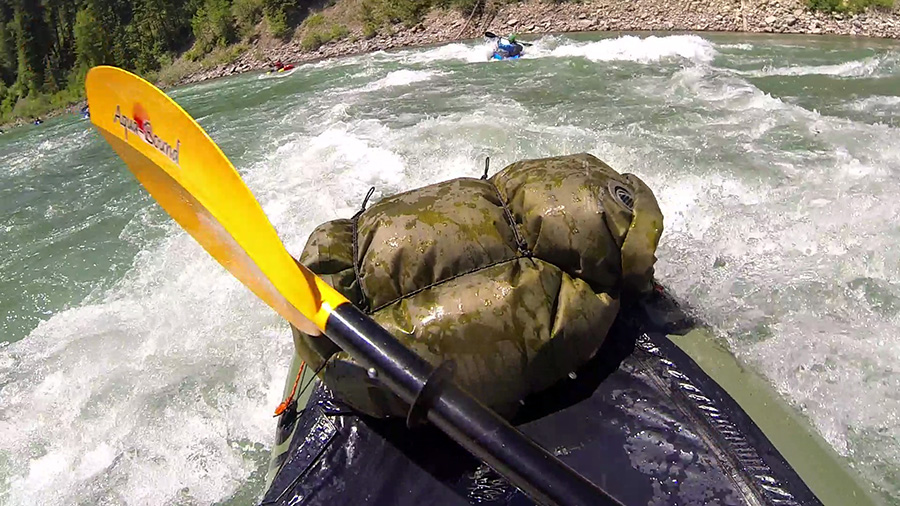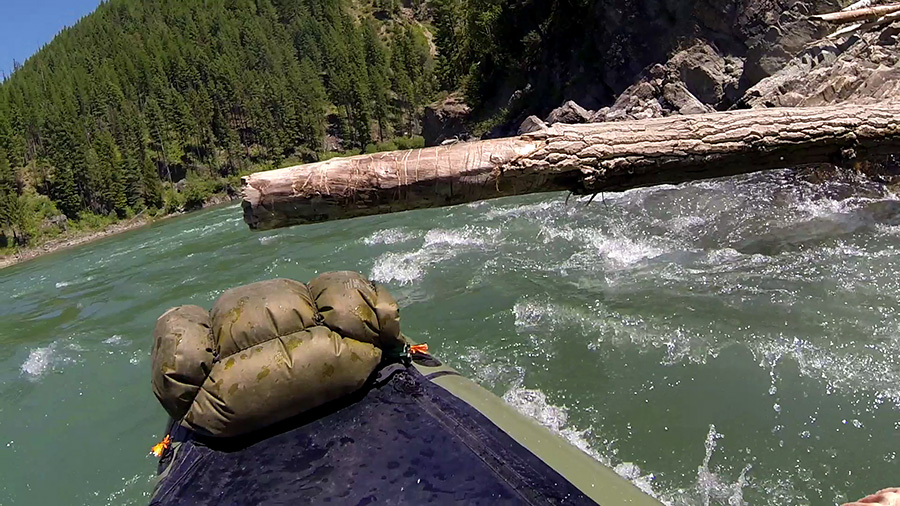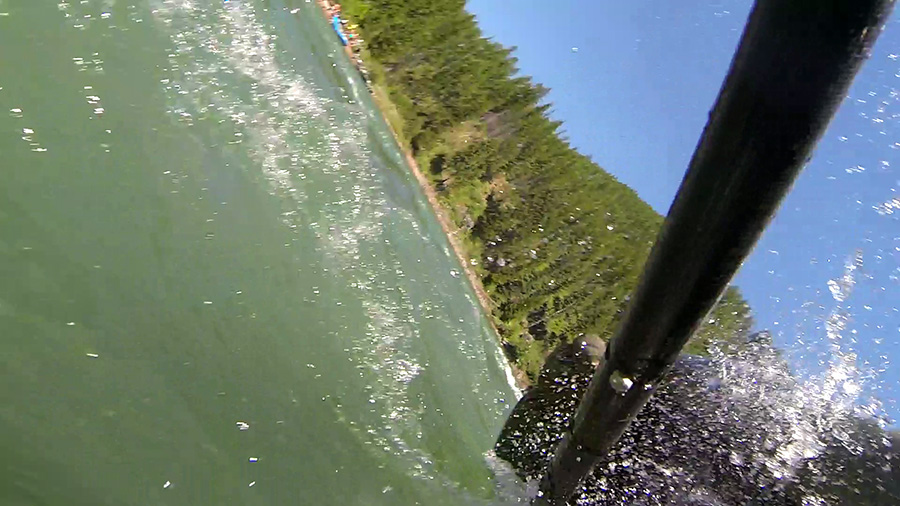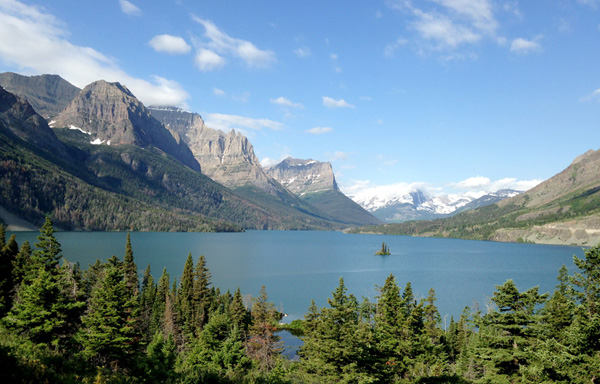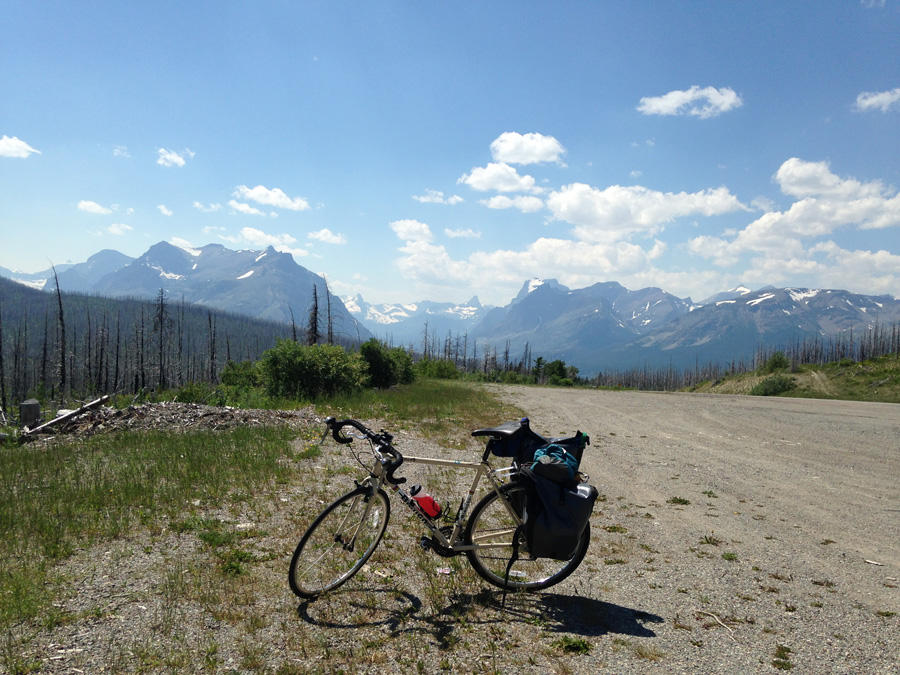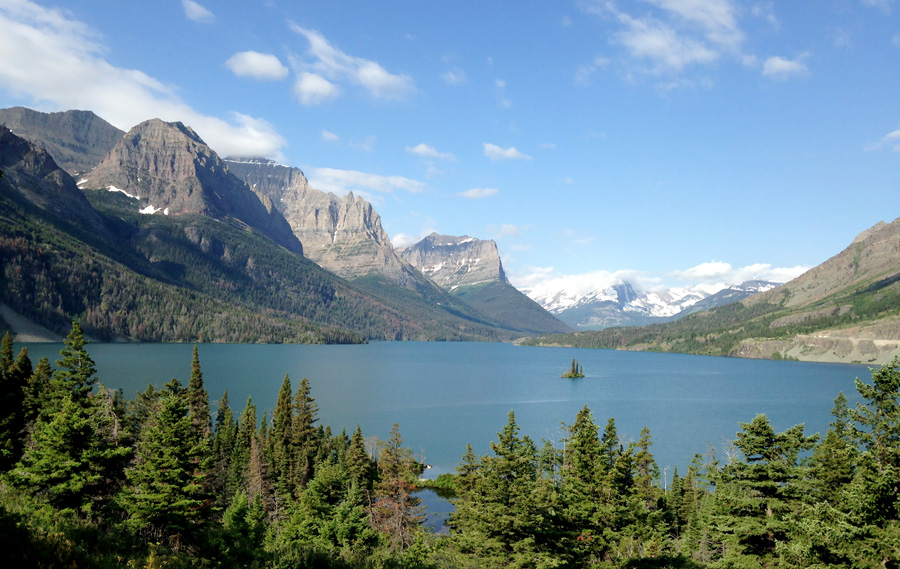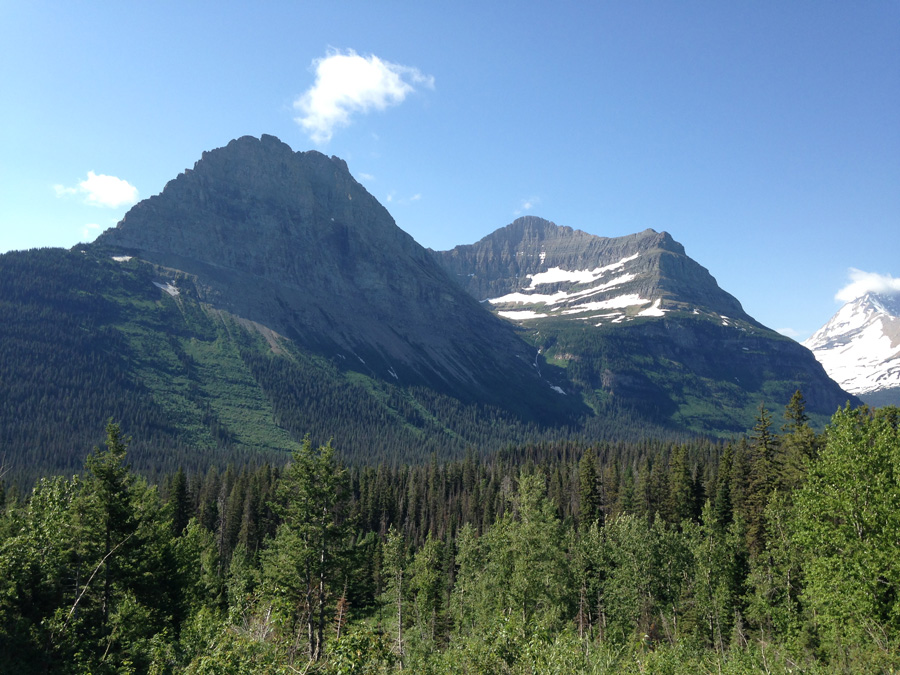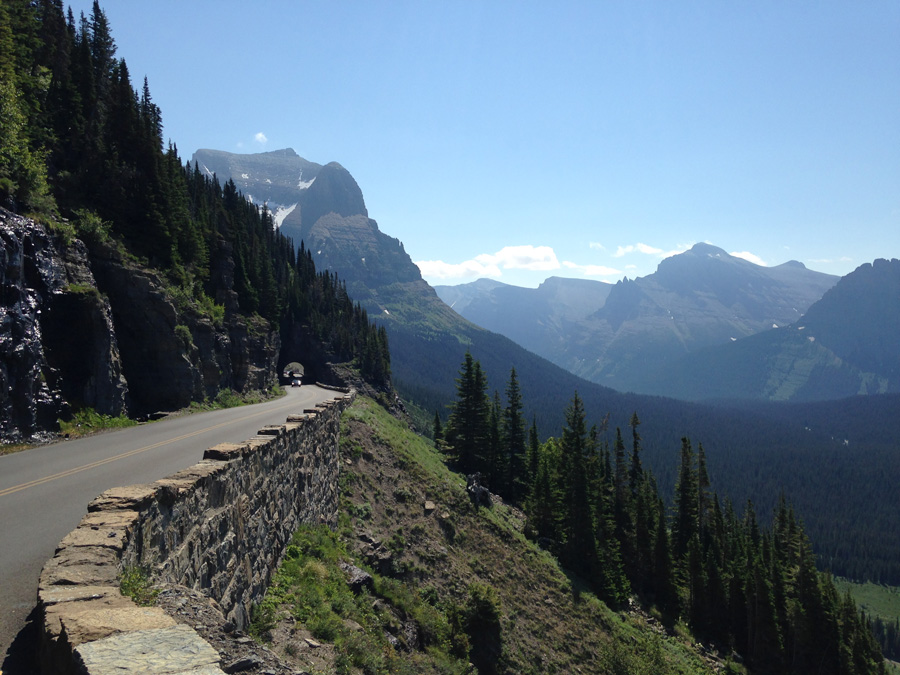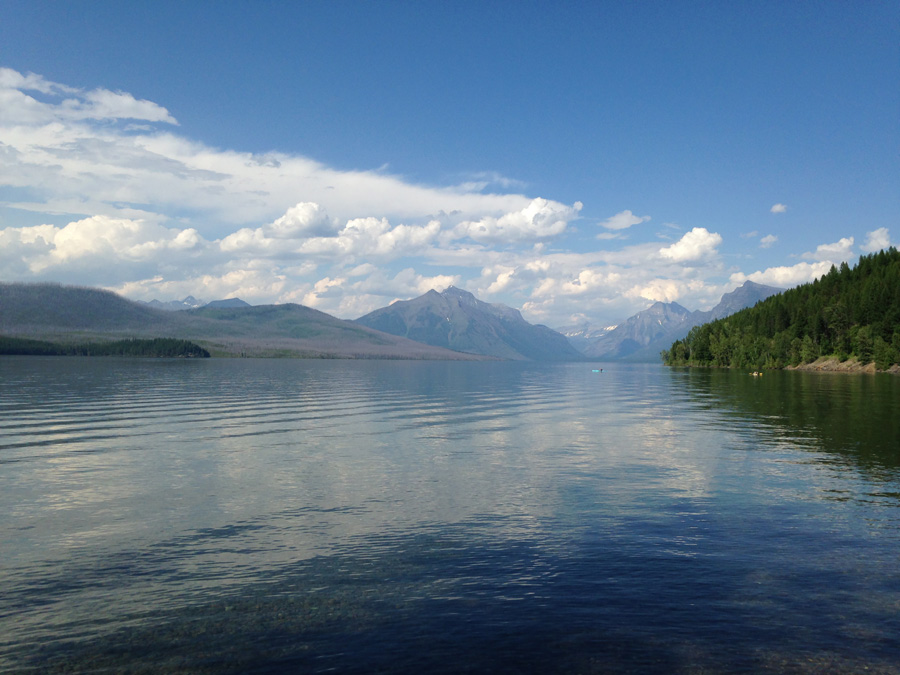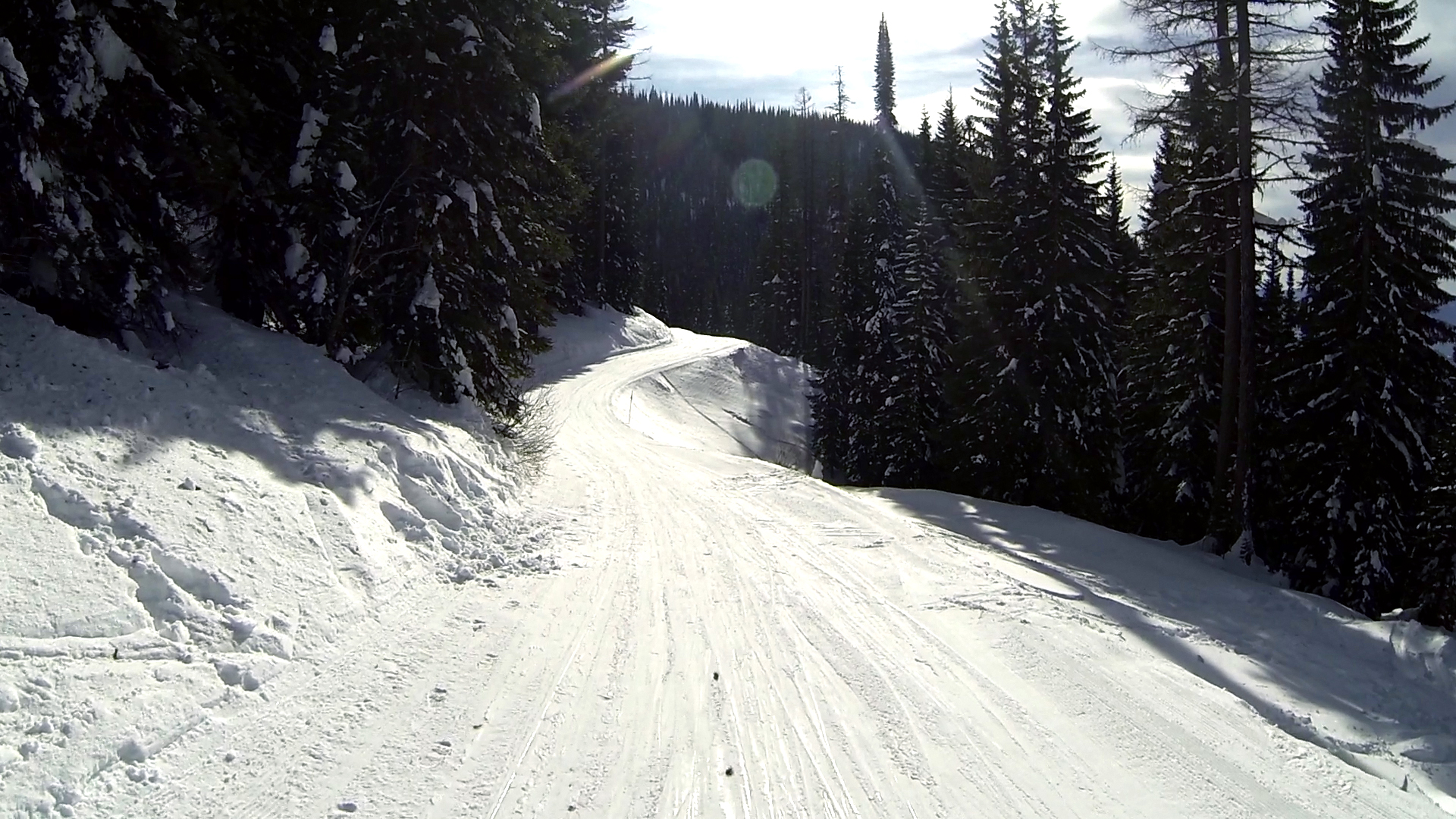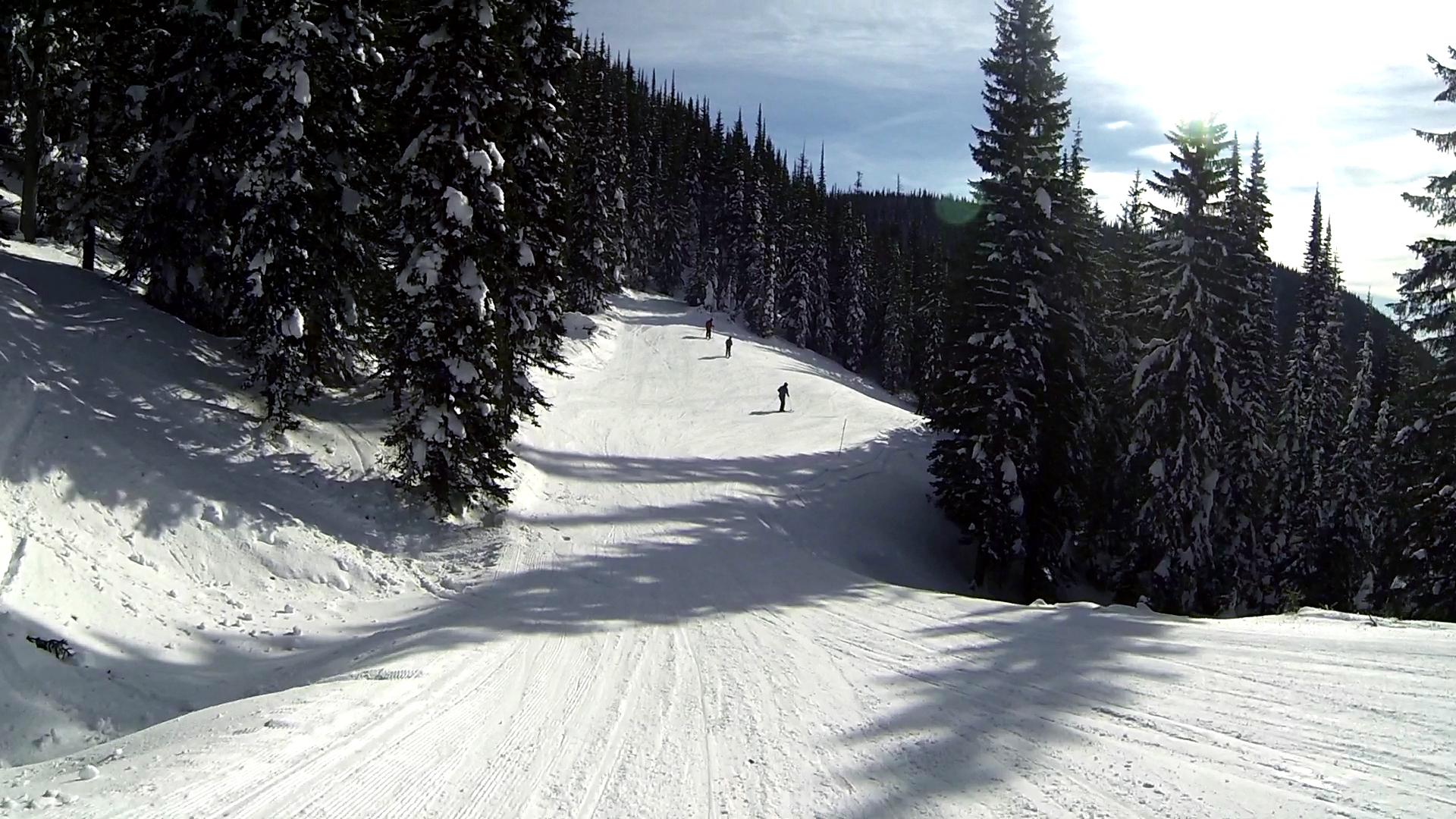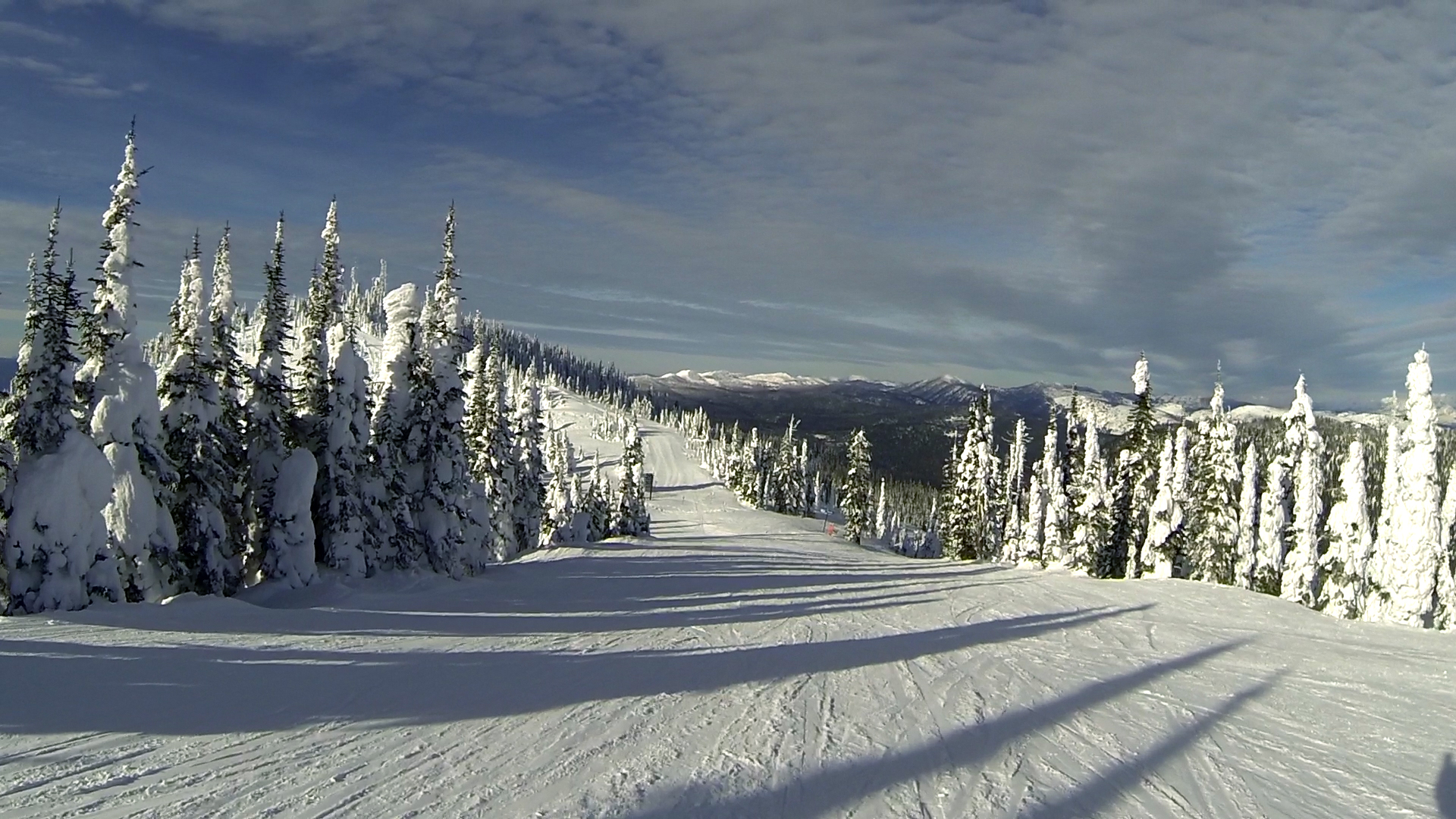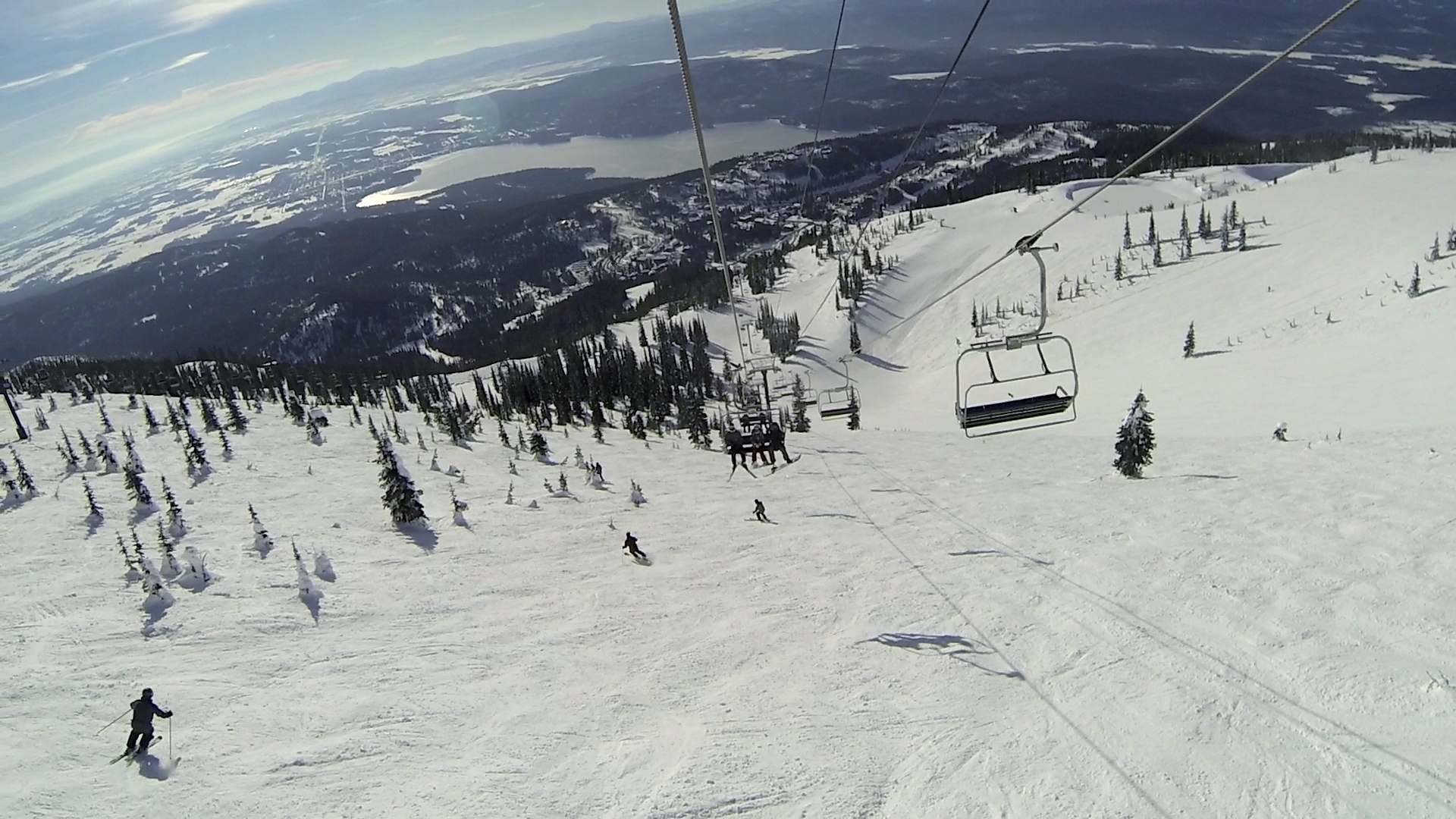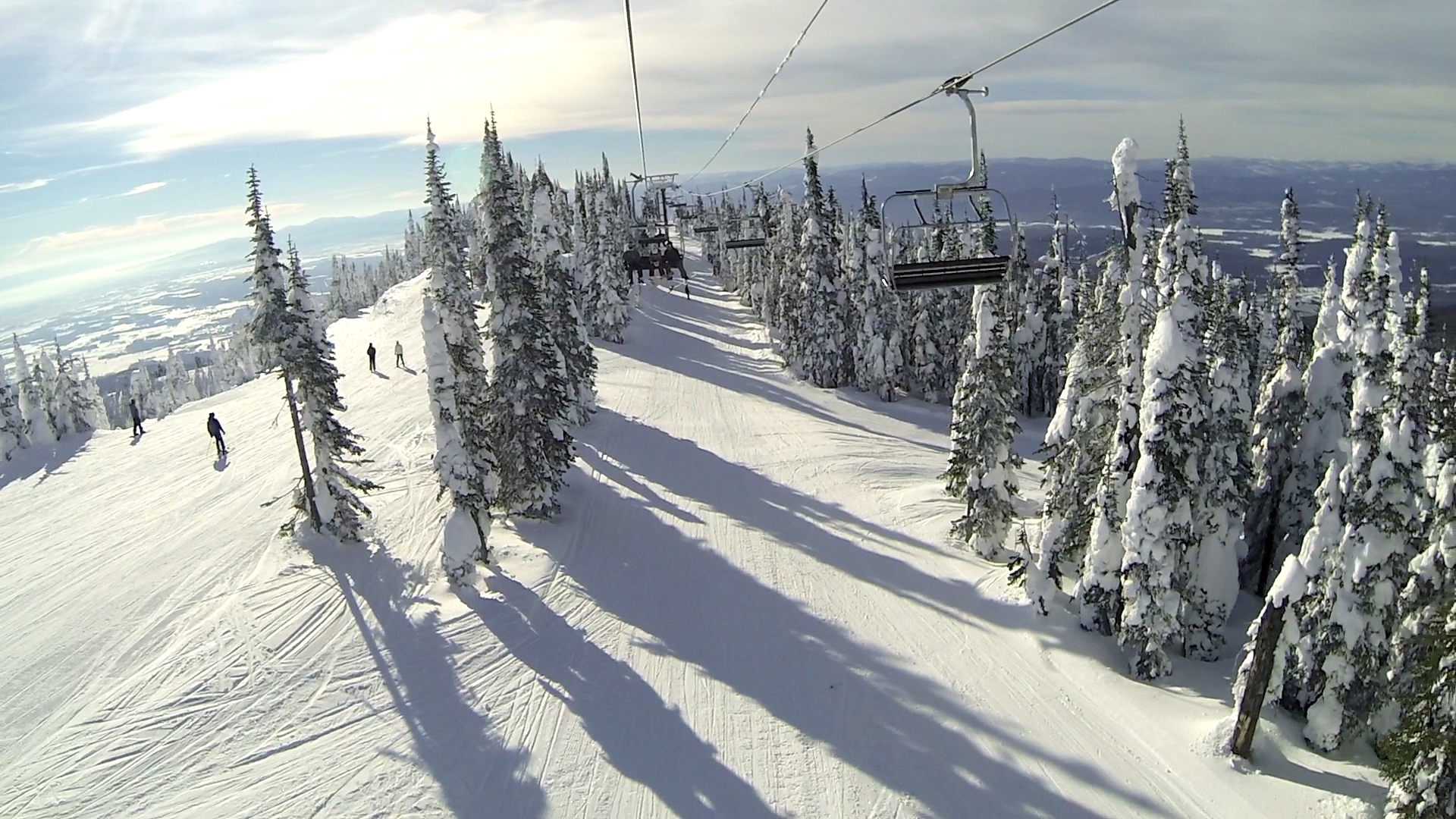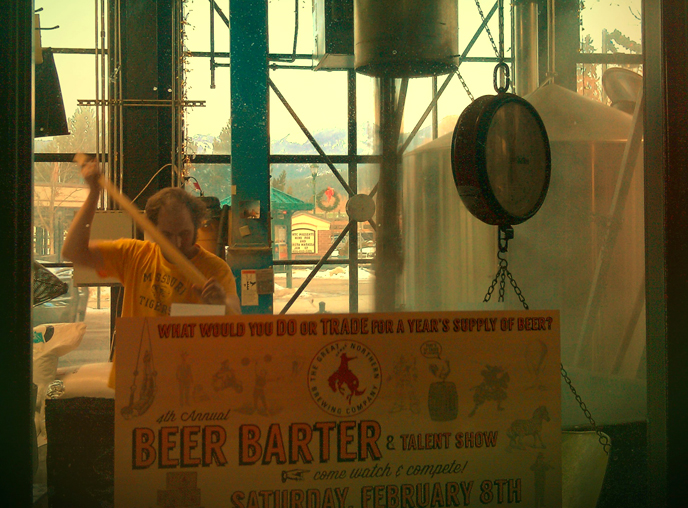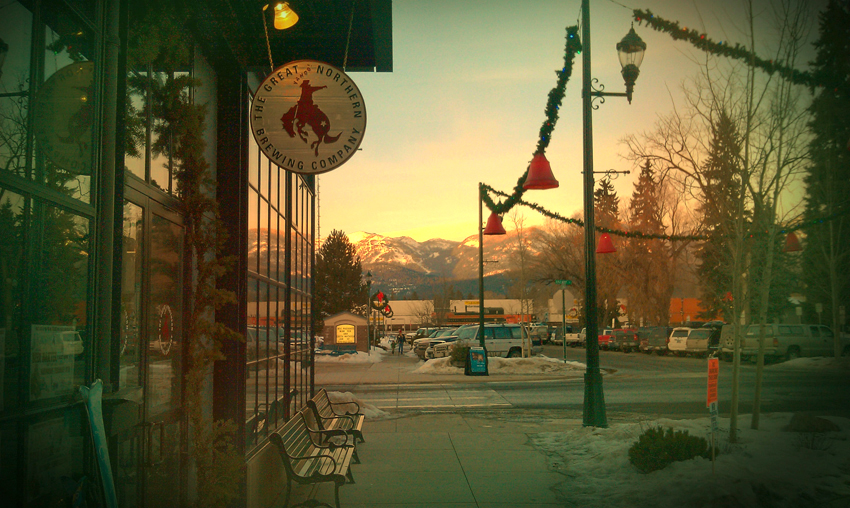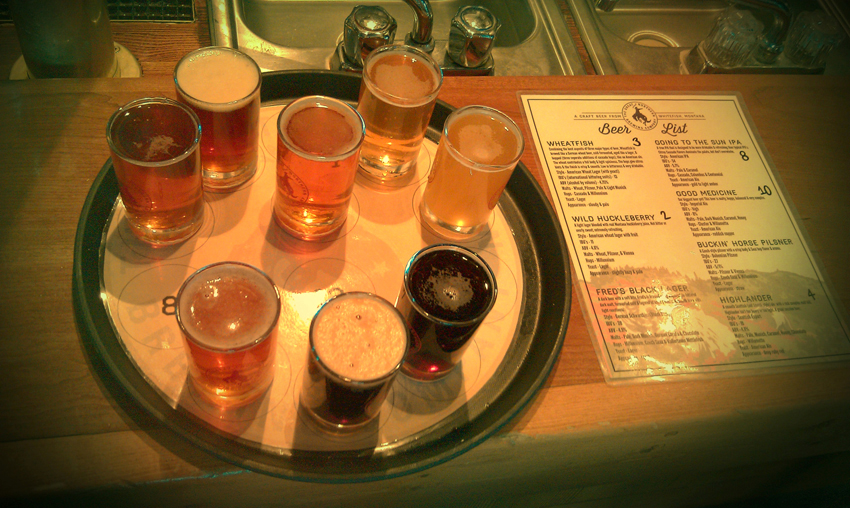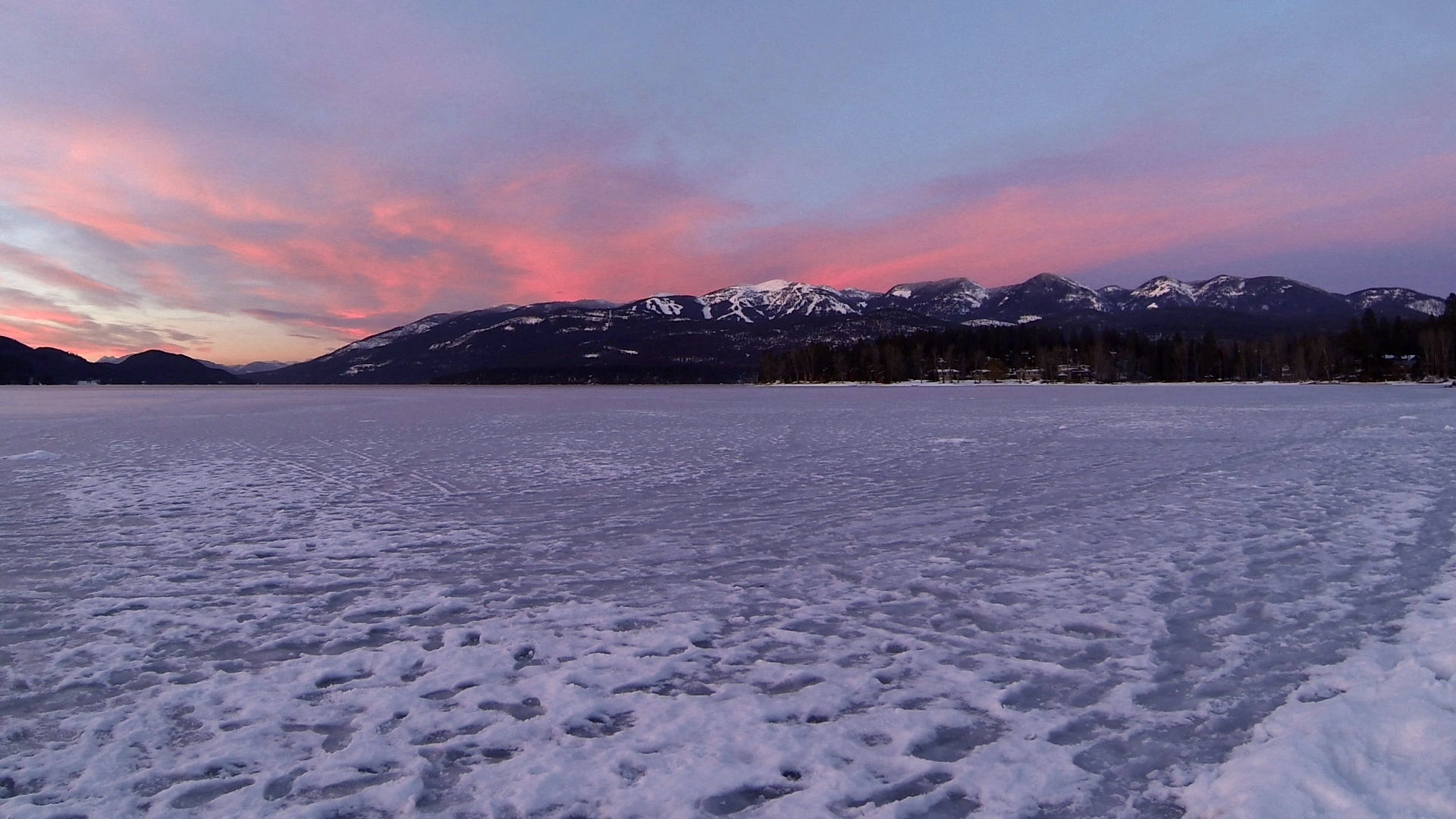APA Roundup: Packrafting the Flathead North Fork
I have had my packraft for two summers now, and it’s one of the best toys I have. I couldn’t even say how many times I’ve taken it out on the city rivers in Chicago. Whenever I’m not on Google researching ideas for bike tours, I’m doing it for river trips. I have come to find that paddling down a river, a wild one especially, is one of the most engaging ways I can take in the beauty of an outdoor experience. So naturally, I wanted to incorporate it into my Montana trip. Luckily, there were already quite a few people out there who were into the same thing.
Packrafting has already been picking up out west over the last ten years or so, and has developed its own niche in the paddling community. As it grew, the most active among the paddlers joined together and founded the American Packrafting Association in October of 2012. Along with bringing the community together, their focus has been on education, swiftwater safety, wilderness conservation, and river access. Lobby efforts have been done to legalize the sport in Yellowstone, Grand Teton, and Grand Canyon National Parks.
This year, they had their first ever roundup, drawing packrafters from all around for a weekend of paddling, workshops, swiftwater rescue training, and presentations focused on their current river conservation efforts. The organizers booked the weekend at a group site at Big Creek Campground, right along the Flathead North Fork. They planned day trips for everybody on that river and others in the park, depending on a person’s experience level.
I was planning logistics for my tour through Glacier around the same time I got the notice for this event, and when I realized it was right along the way, I added it to my tour dates. I wanted to take my raft on a challenging river again, but knew that running Class II-III whitewater alone was pushing it at my experience level (a lesson I learned the hard way on the New River last year). But I knew that these trips would have a guide and other experienced packrafters who I could learn from.
So I rode my bike to the roundup at Big Creek after hauling my ass over the Sun Road, locked it on a tree, set up camp by the river, and planned to spend the next day on the water. Moe Witschard, the main organizer, let me ship my raft and paddling gear to his house in Bozeman and agreed to take it to the roundup so I wouldn’t have to carry it with me on my bike. Cool guy.
I got up the next morning and unpacked the boat, ready to hit some good splashes on the river with my new friends. The organizers split us up into three groups, based on our experience levels. I was placed in the intermediate group, seeing as I wasn’t completely clueless out there, but certainly didn’t feel ready to run the big stuff with the best of them. Not yet anyway.
Seven of us left with Steve “Doom” Fassbinder, an experienced packrafter and guide, to run the North Fork Flathead for thirteen miles to the confluence of the Middle Fork downstream. It was a big river, about 200ft wide and moving swiftly at a high gradient. Even the calm sections had enough power to pick you up and take you away. Most of the rapids were rated Class II-III with a lot of splashes and wave trains. It was fed primarily by alpine meltwater, giving it a clear jade color.
Our group got our gear together, inflated our rafts, and got in right by the campsite. We pushed out from shore and each went flying down the river. As we went through the calmer sections, Doom taught us some of the basic maneuvers, had us practice self-rescue, and explained how he was able to read a set of rapids and find the right line. We spent the morning paddling through a number of choppy wave trains and turning out frequently to calm eddies along the riverside. But we all had a great time hitting wave after wave. People fell out here and there, but since there weren’t many hazards around and the water was deep, recovery was pretty easy.
Later that morning, Doom had us all eddy out at one point to surf a set of playwaves. Other rafters went out ahead and surfed the waves for a moment before either flipping or washing out of the rapid. I finally got the courage to try it, paddled upstream against the wave train, and then got distracted. Julia was paddling right in front of me when her boat flipped. She went right under my raft, I felt her head hit the bottom. She took a mouthful of water and came up six feet away, yelling for help. I started towards her. She got herself together and yelled “I’m fine! Get my raft!”
I turned around and paddled for it, easily catching a grab loop (and making me wish somebody was around to do this when I wiped out on the New River last year). Got it! …what the hell do I do now?
I was out of the rapids, but still flying down the middle of the river. I couldn’t paddle without letting it go, and it was too big to pull onto my boat.. Shit! Think for fuck’s sake!
I turned back upstream, put it ahead, let it go, and carefully ferried to shore with it bumping against my bow, a technique I came to find out later was called Bulldogging. I got it to a calm eddy and got my feet on the ground. Julia came over a minute later, out of breath and happy to have her boat back. It was my first river rescue. Go team.
We stopped downstream a while later at a shaded outcropping for lunch. Moe’s group caught up with us and we all sat on the riverbank with our colorful boats, trading rafting stories and shooting an array of interesting shit. Many of these guys have been on some amazing expeditions all over the place, and couldn’t bore you if they tried.
Eventually, we went back to our boats and eddied back in to continue the run. I was the the last one to get back in, and the only one who didn’t ferry out far enough to miss a large log sticking out thirty feet down. Luckily, it didn’t have any branches, but it was coming right for my face as I moved right at it in the current. I ducked backwards as it brushed over my bow cargo and nicked my helmet. With the sudden weight on the stern, my bow flipped and I got a face full of cold, dark mountain water. I kicked my way out from under and grabbed the bow line. Before I could think about self-rescue, I went right for a calm eddy, where I kicked to shore and recovered my breath on a rocky outcropping.
The rest of the day went smoothly, as the rapids got more and more peaceful. We finally ended our trip at the Middle Fork confluence, and celebrated with some ice cold beer.
We joined up with the other groups at the campsite that night for a huge cookout with plenty of beer, meat, and good food. Afterwards, a couple of speakers shared their experiences working with legislators and park officials to legalize paddling in various parks, and prevent the use of dams in different river systems. A couple of guys from Tasmania did a presentation on the Franklin River, where packrafters were successfully able to halt a dam construction project and preserve its pristine beauty. It was all really cool, but my exhaustion had finally caught up with me. I had a massively bad splitting headache, and I was feeling tired out from the last weeks worth of nonstop exploring.
I crashed hard and slept harder.
When I got up the next morning, the groups were gearing up for another good day on the water. The beginner level planned to do the same run that my group did yesterday, and my group was preparing to hike somewhere north for several miles and hit a more technical section of the river. I wished them luck and left the campground with my loaded bike, turning southward on a shitty gravel road towards Whitefish.
I hate gravel. My touring bike is durable enough to handle it, but it doesn’t maneuver for shit. And on this road it was even worse because they just poured new gravel on it. I had to go painfully slow, especially downhill, to keep from spinning out and falling sideways. It was two hours that I don’t care to go through again.
Eventually I hit smooth pavement and had an uninterrupted ride all the way to the Whitefish Hostel. I’m sure by that point I had to have smelled like fucking apple blossoms. So I put my bags down, took a gloriously hot shower, and slept like a king for the rest of the afternoon.
I had two days to relax. And unlike my tour, which I planned down to the numbers, there was no agenda. And that’s exactly how I liked it.
Glacier National Park
Day 1: East Glacier
I woke up somewhere in the mountains west of Whitefish. Looking out, the rolling hills passed by, and an occasional lake appeared. It was 7am, and I needed coffee. We were four hours late, thanks to a delayed connection in Spokane. But I didn’t care. Coffee was all that mattered.
I had left Portland the night before in the late afternoon, passing by the Cascades and into the deserts of central Washington. I had taken my bike up to some high places and saw some great parts of the northwestern country. But it was behind me now, and bigger challenges lay ahead.
I approached Glacier National Park, the location of my second bike tour on the trip. I planned to tour the Going To The Sun Road, a world famous road that winds treacherously along high mountainsides and through the middle of the park. It draws multitudes of tourists, backpackers, and cyclists every summer. Its panoramas are out of this world, and I finally had my chance to see them.
I planned to ride it from the east, starting in East Glacier, 30 miles south of the St. Mary end of the road. I would spend the afternoon of my first day there getting my bike and gear back together, and then leave the next day on a half day ride northward to the St. Mary Campground and the edge of the Sun Road. Then I would spend another day going through the mountains to the western side of the park and pedal out to Big Creek Campground, spend the next day packrafting down the Flathead River, and then end the trip with a short ride to Whitefish.
The train dropped me off in the late morning with my bike box and loaded backpack, which I had to haul across the road to the East Glacier Lodge. My friend Tim recently moved there from Chicago, and worked in the lodge restaurant. He let me crash in his dorm in an extra bunk before my ride the next day. This gave me the afternoon to unpack my bike and get my gear together.
I spent two hours outside of the lodge assembling my bike and organizing gear when I gave it a test run and shifted to slipping gears. I tried turning the barrel adjuster, which has done the job before. Didn’t work, as the derailleur indexing was altogether out.
I should know how to do this. There is a way to change the position by turning the screws. But I don’t remember which way, and this was not the time to really mess something up. I needed it fixed and ready by the next morning.
I made a quick phone call to a bike shop in Whitefish, rented an SUV, threw the bike and my extra baggage in the back, and drove for two hours in the mountains to get it fixed. This wasn’t entirely a waste, as I still had to get my bike box and extra stuff to the hostel there anyway, and this would eliminate the hassle of shipping. So there’s that.
I got to the shop late in the afternoon, and they were glad to take a look at the bike, even though they were way behind on other orders. I dropped it off and went to the hostel to leave my bike box and extra gear. They let me put my stuff in one of the back rooms for the next few days, which was supremely helpful. I sorted out everything that I wouldn’t need to tour, put it in the box, and left it in the back of the building.
How convenient that I was as stressed as I was and right down the street from the Great Northern Brewery, because their Huckleberry Wheat Lager was as delicious as last time. I got a glass of that and a BLT from the kitchen. I was almost done eating when the bike shop called to let me know that my bike was ready.
A well-earned shout out goes to Glacier Cyclery and Whitefish Hostel for helping me work out the details when in a bind. I won’t hesitate to deal with them again, and recommend them to anyone going through that area. I picked up my bike and headed back on a two hour drive to East Glacier, where I dropped the car off and rode my bike back to the lodge.
I found Tim, who was getting a team together to play Ultimate Frisbee in the front lawn. It was the first time I had played a sport like that in years, and I was surprised at how tired I got, despite everything I had done on a bike so far. Our team got whipped for two games, but it was a good time. We finally quit when the sun set behind the western mountains.
Four of us went to the lodge balcony and watched the sky turn red above the huge rugged mountains of Glacier’s eastern edge. It was good to finally relax after my shitstorm of a day. I polished the night off with a glass of bourbon and went to sleep in Tim’s dorm room.
Day 2: St. Mary
I left early the next day for a 30 mile ride northward through the foothills to St. Mary Campground, right by the entrance to the park. There were a few long, steady climbs under the hot sun, but nothing too bad.
The flies were the bigger pain. They flew around me whenever I couldn’t ride fast enough to outrun them. Whenever I got to a climb, they started to land on my arms, legs, face, in the vent holes of my helmet, one even got under my sunglasses. In the middle of one climb, I batted at one, lost my balance, and crashed on the gravel off of the shoulder. I was going too slow to cause any injury, but I scrambled back onto my bike feeling pissed all the same.
I reached the hills above St. Mary after a few hours. For miles around, countless rolling hills bore the scars of a huge forest fire, likely caused by thunderstorms. Though the woodlands were gone, the countryside nonetheless was vast and beautiful. There is no question that Montana brings with it a tremendous sense of openness and solitude. I descended down a steep hill to St. Mary Campground, checked in, and set up camp along the edge of the range under a blazing mid-afternoon sun.
I went to sleep just after dusk that night. An hour later, the wind picked up, and my eyes snapped open at the sense of lightning flashes outside. Thunder was coming.
I got out and saw a huge thunderhead passing ten miles north. The light of dusk illuminated it from the west, and the rest of it glowed in sight of the rising full moon, flashing and flickering soundlessly into the night. Gusts of warm summer air blew across the campsite, though the storm that caused them was too far away to cause any trouble. To the south, the full moon broke through a band of clouds just above the silhouette of Curly Bear Mountain. Small moonlit clouds raced across the sky above as the night darkened, with stars appearing more and more by the minute.
I see a lot of memorable things on my trips, but there are times when even the best of them don’t come anywhere close to this. On that night, the sight of a giant thunderstorm rolling across an alpine wilderness was a truly otherworldly thing to behold. Unfortunately, I didn’t watch it for long. I needed to get my rest for the next day. I got back in my tent and fell asleep to the rustling wind, which blew against the tent all night.
Day 3: Logan Pass
It was game time. I packed up and got moving on the Sun Road at 9:00. It quickly met St. Mary Lake, where it went on for 9 miles. It was mostly flat riding near the lakeshore, with a few negligible hills that I cleared whenever turning towards the mountains to my right.
I recognized all of the places where Jack Torrence drove his family on their way to the Overlook Hotel. I see why Stanley Kubrick picked this road for these shots, and respect is due.
Halfway along the lake, I hit gravel. A girl at the East Glacier Lodge told me that crews were working on the road for 8 miles or so up the east side of Logan Pass, and to expect gravel for the whole thing. Shit. That I did not want to hear.
It was already a hard climb just to get up to Logan Pass. At a 6% inclide, 2,000ft elevation gain, the uphill fight lasts for 6.5 miles. Trained or not, it wouldn’t be easy. But with a gravel stretch for the first four miles of the steeper section, it would be even worse. I looked ahead for the smoothest parts of the gravel road and steered accordingly, usually along the tire tread of the vehicles.
As I approached the pass, the mountains on the far end of the lake seemed even bigger and higher, covering half of the morning sky. The road steepened and turned gradually to the right around Going to the Sun Mountain. This was it. This was the climb. All of the buildup, the hassles, the training, all of that shit. This was what all of my busting ass had come to. It came down to this. Getting through this climb with my sanity, and making it down the other side with my bike in one piece and a story to tell.
I shifted down and slowly pedaled over the dirt and pebbles, looking out at the vistas to the left whenever it was okay to look away from the road. Before very long, the forests disappeared below, and the peaks of Little Chief and Citadel Mountains stood resolute on the far end of a terrifying ravine. I pushed onward, shaded by the trees to my right.
The dirt road finished its turn around the mountain and made straight for Siyeh Bend, a switchback over a small stream between Going To The Sun and Piegan Mountains that marked the second third of the climb, the end of the gravel, and a good place to take a break. When I finally hit pavement again, it felt like a luxury.
I stopped at the overlook, and like the climb up Mt. Hood, was a bit surprised at how much easier it was than expected. Even with cargo, even with gravel, even with a hot alpine sun, it wasn’t that bad. I took a break, feeling pretty good about the two miles I had left. With the help of pavement, I would kick its ass for sure.
I got going and shifted a couple gears up for a smooth pace all the way to the summit. What the hell? It wasn’t supposed to be this easy. It was mildly irritating.
But I made it, and had time to relax.
At the top of Logan Pass is a big visitor’s center that is swarming with people in the summer. Inside, they have a few exhibits about the park’s key landmarks and history (disappointingly, nothing about The Shining. You could learn a lesson from Timberline, Glacier National Park), and presentations by the park rangers. I wasn’t really interested in any of this, but I did want to see Hidden Lake, which requires a short 1.4 mile climb over the pass above the visitor’s center. The rangers let me leave my panniers safely in their break room, which was cool of them, and I started climbing up the trail.
What I didn’t realize was that even though it was the middle of the summer, and the alpine sun was blazing on the mountainside, the snowpack was STILL THERE, and was taking forever to melt. Almost the entire trail, a wooden walkway that can be easily traversed when you can actually SEE IT, was covered in snow. I did something that I don’t recommend, and hiked it wearing Keens and wool socks.
Every minute or so, snow would pack into ice under my feet, freezing whatever it could through the layer of wool. It was never cold enough to cause any worry, given that the wool insulated just well enough, and there was the sun helping to thaw my feet out from a horrible angle in the sky. I scrambled along, with sandals slipping every few steps up the snow, and the glare of the ground turning pink in my vision, thanks to my losing my sunglasses yesterday in St. Mary.
It went on like that for a shitty hour. I finally made it to the wooden platform and lookout to the lake. Disappointing. The small valley and lake were still melting in snow as well, and it just looked like a slushy mess. I figured it would look a lot more picturesque later in the summer, but for now, was way off on the cost/benefit ratio. But hey, how could I have known if I hadn’t gone out there, right?
(Actually, I stand corrected in hindsight. I just went back and edited this panorama, and realized the extent of my mistake.)
I walked, trotted, and slid down the snowpack for another hour before finally getting back to the visitor’s center. It was time to get my stuff and get going. The western end of Logan Pass descends at the same 6% grade as it does coming from the east, the key difference being the distance of the descent. It goes farther down, dropping another 1,000 feet in elevation before reaching Lake McDonald and the western side of the park. So whether you climb from that way, or you descend it, you’re going for longer. That aside, it’s pretty much the same.
Passes like this pose two big challenges to me: First, getting up to the top of them, and second, flying back down without crashing and busting my crazy ass on the side of a cliff. I made it up there easily enough, but knew that getting down the other side would mean a steep descent along the twists and bends on the vertical face of Pollock Mountain.
I got started downhill behind a car and a utility truck in front of it. We quickly descended out of the pass and started winding along the mountainside, going past waterfalls and streams of fresh snowmelt. Mt. Oberlin stood high across the canyon to my left in resounding magnificence. Before long, the view down McDonald Valley opened to the west in a forested carpet, fading into the haze of the afternoon.
I continued flying down the turns and bends of the Sun Road, amazed that I could keep up with the cars in front of me. I realized that vehicles on this road were pretty slow going. And at that descent, I was obviously going faster than usual. I went by the Weeping Wall, a spot where small waterfalls pour onto the side of the road, and got a fresh spray of mist in my face. I didn’t care. I was having too much fun.
I chased a car around The Loop, the lone switchback on the western side, and descended two more miles through forests to McDonald Creek and the end of the grade. From there, it was smooth riding all the way to Lake McDonald.
I was surprised at how smooth, driveable, and bikeable the road was, gravel aside. I guess if the state spends millions each year to keep it open, it better be. It is certainly one of the best roads I have ever seen on a bike, and I was satisfied that I finally got the chance to ride it after more than a year of buildup.
But the day wasn’t over yet. I still had to ride another 30 miles to Big Creek Campground, and I was in no mood to do it. I went along Lake McDonald at a worn out pace for 10 miles, turned north at Apgar Village to Camas Road, climbed for 45 minutes uphill, then descended the same distance down to the Flathead River. From there I turned west, and pedaled a final shitty three miles in gravel to Big Creek, checking in a couple hours before sunset. That night, I slept well by the rush of the Flathead North Fork. I was wiped out, and needed all the rest I could get for what would certainly be a big river trip the next day.
Skiing Whitefish, Montana
Skiing Whitefish, Montana
I never enjoy the winter in Chicago. And this one has been the worst one I’ve seen since I moved out here five years ago. We have had temperatures and snowstorms that have truly challenged my patience with this city. But I like it here, and I endure it. I endure things like frozen pipes, sub-zero temperatures, and accumulation on the sidewalks that melts into piles of ice, trash, and dog shit. I hibernate as much as I can to avoid it, but no one can stay indoors all winter. So I decided this year that if I’m going to freeze my ass off, I might as well do it somewhere that I can ski.
Northwest Montana always stood out to me as a place worth visiting. I used to look at maps of the area as a kid and remember being curious about the Flathead Valley even back then. And I had already recently mapped out a bike tour on the Going The Sun Road in Glacier National Park. That would happen in the summer, obviously, and plans for that are still in the works. But I realized that the cold season there has its own share of options when it comes to outdoor recreation, namely Whitefish Mountain, a kickass ski resort just north of the town.
The logistics involved in getting there didn’t seem too complicated. Amtrak’s Empire Builder line went straight there from Chicago on its way to Seattle, the Whitefish Hostel in downtown had a good rate and good reviews, and the town had a shuttle bus that went up to the base lodge every thirty minutes. The only thing I didn’t know yet was just how much trouble it would be to take that train across the Midwest in the dead of winter.
I found out soon enough as I boarded an already late train on Saturday evening. In theory, it was supposed to take 30 hours, but by the time we reached North Dakota, that clearly wasn’t happening.
Like other lines around the country, the Empire Builder shares the track with freight companies, whose trains always have priority. Currently, there is a huge oil boom in North Dakota, meaning that anywhere with a 200 mile radius of Fargo will probably be congested with freight traffic. We stopped for hours at a time to let one freight after another go by, all carrying millions in black gold across the heartland. I was supposed to get to Whitefish at 9pm on Sunday, but didn’t actually get there until 6:00 the next morning. That kind of shit, from what I gathered from the conductors, was apparently normal.
But I knew right away that it was worth it. My 40 hour ordeal ended when I stepped out of the train car and into a tiny mountain town in a big country. Whitefish sits on the north end of the Flathead Valley, and at the foot of Big Mountain, whose ski slopes are visible for miles around. The town is full of good places to eat, good beer to drink, and good people to meet. And I would do it all. But first I needed to find the hostel, check in, and get my head together.
Daybreak came an hour later. It was a warm, dreary morning with steady rain that turned the snow into ice and slush. The cloud line covered the top half of the mountain for most of the day. With all the rain and poor visibility, I knew it wasn’t time to go up there yet. So I got comfortable for the next couple days and worked remotely on my laptop for my company in hopes of better weather later on. Pretty much the same thing I did in Anchorage.
The sun came out on Wednesday morning, I walked three blocks to the Snow Bus shuttle, and before I knew it, I was riding on a lift up the side of Whitefish Mountain, leaving the valley floor and base lodge behind in the glare of the morning sun.
The resort is huge. With 93 runs and 9 chair lifts that spread out across the ridge, you can spend an entire day in one section and not get bored. After a few easy runs on the bunny hills, I took the express chair up to the summit, which offers an unbelievable 360 degree panorama of the big sky country.
It is the kind of view that will kick the breath out of you the first time you see it. To the west, Whitefish Lake glares under the winter sun; to the south, Flathead Valley reaches past Whitefish and Kalispell and fades into the haze; and to the east, the snow-capped, rugged peaks of Glacier National Park carve high into the blue sky like jagged razor teeth. Snow-dusted, evergreen woodlands spread across countless ridge lines, and at higher elevations, they are covered in so much snow that the locals refer to them as “snow ghosts”. It is a vista that can easily rival most of what Alaska has to offer (and I seriously do mean most; there are places up there that are too vast and wild to ever be outdone by the rest of North America).
And right in the middle of it all is the Summit House, a lodge at the summit which offers a bar, restaurant, and spectacular panoramic view of the mountains. Perhaps the idea of a hot Irish Coffee might sound appealing as you relax on the balcony and watch the other skiers go down the big runs. If I wasn’t in such a hurry to shred the face off of the mountain, I might have stuck around longer.
Instead, I turned towards the northwestern ridge line towards Hellfire, a badass blue square run that winds narrowly through the forests on the edge of the resort for three miles. It turned about through the trees, and had many steep descents that were followed by more level, easier places to recover my footing before going even further down.
But compared to the others, it was easy. Other trails like Hellroaring, Swift Creek, Ed’s Run, and many others, all faced the valley more directly, extending straight down to the base lodge at the bottom. It was terrifying at first to look out at the valley floor, some 2,300 feet down. I thought for sure as I carved into those trails that I would crash and tumble down the mountainside in an avalanche of powder.
Some locals told me about Inspiration, a large blue square run that had just been recognized by CNN as one of the Best Ski Runs in the World. Not wasting any time, I went back up to the summit to check it out. I went out on the south ridge, terrified that I would go over an edge and crash into a snow goblin. The slope turned sharply away from the ridge and ran straight down the face of the mountain.
Inspiration was indeed beautiful; mind-blowing, actually. But her beauty could only be matched by sheer terror. In full view of the valley ahead, she ran like mad down the mountainside with no easy way get through other than head on. I wiped out again and again before my busted ass finally got to the bottom.
I thought about taking a break, but decided that I wasn’t going to learn anything if I didn’t challenge my limits. Giving up is not something I would easily or lightly consider, not yet. The day Hagen gives up after the first run is the day he trades his beard for a mustache. I went back up to the summit and took on that trail and the others again, and kept on keeping on, wiping out like a sonuvabitch.
This went on for three days. I got up, walked to the shuttle, spent half a day on the mountain, came back and enjoyed all the food and beer in the town, and then got a good night’s sleep at the hostel. And I couldn’t have asked for better weather. The sun was out and lighting up the country as far as the eye could see. It was the kind of day that got the locals out and moving.
There are good people in Whitefish. With so many folks around who love the outdoors, I felt right at home. Many of the regulars on the Snow Bus were eccentric retirees, the same kind who see me in the summer with my bike and hundred mile stare, and want to know where I’m headed. There was a sweet old lady in a walker who told me one day that she used to ski the Big Mountain in her younger years. In downtown, many of the locals ski and snowboard the mountain, snowshoe Glacier, and in the summer, who the hell knows.
And then there’s downtown itself. It’s a tiny place. But it’s loaded with gift shops, sporting retail stores, sports bars, craft beer, and game food. On my last night there, I polished off a hard day of skiing with a beer sampler at the Great Northern Brewery. The bartender gave me 8 different draughts to try out, and by the 4th one, I was already feeling pretty toasted.
I’m usually in the mood for a full, malty, stouty glass of black gold in the cold season, but a completely different kind of beer, the Wild Huckleberry Wheat Lager, got me by surprise. Brewed with Montana’s own huckleberry juice, it had a kind of sweetness that I normally don’t taste in beer. There was almost no bitterness at all, and it had a smooth foretaste that gave way to a sweet, fruity flavor and a refreshing finish to my week.
Well, almost. I still had to drink the other glasses.
To my right, the brewhouse was in operation and a new batch was underway. A brewer poured ingredients from a chute into a large bin and mixed them in plain sight of the bar. I don’t know what he was brewing, but the aroma that filled the room was not unlike sweet molasses.
Early the next day, the Chicago-bound train was an hour late. I made the most of my extra time and went back to Loula’s, a cute little diner just down the street from the hostel, to get a hot breakfast and chat with the sassy waitresses. I loved that town and hated to leave.
But I had to. I had to leave for what would certainly be a long and shitty train ride back home. But that was alright. I would be back again. There is no keeping me out of places like this. And it was already shaping up to be a fine day.
The train left the depot at sunrise. It reached the edge of the valley and began its climb towards Marias Pass and the bottom edge of Glacier National Park. Fog came off of the Middle Fork of the Flathead River, but pretty soon the clouds lifted as the sun broke over the higher alpine sections of the range. The train stopped at the town of Essex, continued its climb towards the pass, and then descended down the other side towards East Glacier. Before long, the ranges began fading into the west.
I was pretty sure as I left those mountains that my beard had changed. It was already awesome, but there was an aura about the place that made it even bigger, fuller, more resolute, unwavering and steadfast in its rugged manliness. Not even Chicago at its coldest could penetrate that jungle. It was like flames coming off of my face. And likewise, my chest hair evolved into a great red carpet that could insulate against anything that the Midwest tries to throw at me. I have Montana to thank for this.
I finally got back to Chicago 35 hours later, pretty good by Amtrak’s standards. It’s back to hibernating for now, but I’ll be back with my bike in a few months.
So would I recommend a trip like this to other people who enjoy the outdoors? True, you may have to ride a train for what feels like fucking forever. And you’ll almost think it’s not worth it. But then you’ll get to a kickass little mountain town, realize how big the sky is, and find all kinds of things worth writing about.
